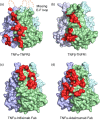Current approaches to fine mapping of antigen-antibody interactions
- PMID: 24635566
- PMCID: PMC4107663
- DOI: 10.1111/imm.12284
Current approaches to fine mapping of antigen-antibody interactions
Abstract
A number of different methods are commonly used to map the fine details of the interaction between an antigen and an antibody. Undoubtedly the method that is now most commonly used to give details at the level of individual amino acids and atoms is X-ray crystallography. The feasibility of undertaking crystallographic studies has increased over recent years through the introduction of automation, miniaturization and high throughput processes. However, this still requires a high level of sophistication and expense and cannot be used when the antigen is not amenable to crystallization. Nuclear magnetic resonance spectroscopy offers a similar level of detail to crystallography but the technical hurdles are even higher such that it is rarely used in this context. Mutagenesis of either antigen or antibody offers the potential to give information at the amino acid level but suffers from the uncertainty of not knowing whether an effect is direct or indirect due to an effect on the folding of a protein. Other methods such as hydrogen deuterium exchange coupled to mass spectrometry and the use of short peptides coupled with ELISA-based approaches tend to give mapping information over a peptide region rather than at the level of individual amino acids. It is quite common to use more than one method because of the limitations and even with a crystal structure it can be useful to use mutagenesis to tease apart the contribution of individual amino acids to binding affinity.
Keywords: antibodies; antigens; crystallography; epitopes; peptides; structural biology.
© 2014 John Wiley & Sons Ltd.
Figures





References
-
- Chothia C, Lesk AM. Canonical structures for the hypervariable regions of immunoglobulins. J Mol Biol. 1987;196:901–17. - PubMed
-
- Lefranc MP, Pommie C, Kaas Q, et al. IMGT unique numbering for immunoglobulin and T cell receptor constant domains and Ig superfamily C-like domains. Dev Comp Immunol. 2005;29:185–203. - PubMed
Publication types
MeSH terms
Substances
LinkOut - more resources
Full Text Sources
Other Literature Sources

